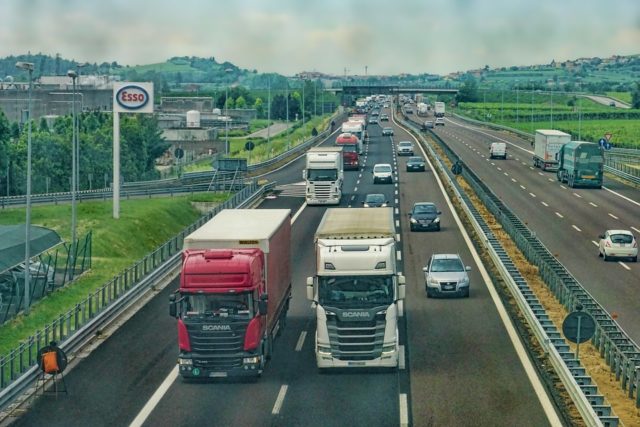
transport
Caution: road (safety) work ahead!
This story started almost ten years ago. In 2010, in the Policy Orientations on Road Safety 2011-2020, the European Commission acknowledged the significant fall in mortality on European roads between 1992 and 2010 from 70.000 to 31.000.
Hence, it set a rather ambitious target: halving the number of road deaths again by 2020. Between 2010 and 2013, the figures dropped by 17%. After two years of “alarming stagnation” in 2014 and 2015, road fatalities shrunk by 2% in 2016, and again in 2017, when 25.300 people lost their lives on EU roads. Fast forward to April 2018. Releasing the data on road deaths in 2017, the Commission added that for each person killed in traffic crashes, about five more suffered serious injuries (roughly 135.000 people).
time for action
To fend off criticism for failure to reach the 2020 target, the Commission presented a proposal for a revision of the General Safety Regulation (GSR) and the Pedestrian Safety Regulation (PSR) as part of its Third Mobility Package. In May 2018, it renewed its commitment to reduce fatalities by 50% between 2020 and 2030. Responding to calls from both EU Ministers and the European Parliament, the proposal introduced smart driving assistance systems in passenger cars, vans and trucks. These include a mandatory introduction of lane departure warnings, lane-keeping assistance, advanced emergency braking systems, software that detect other road users out of plain sight, intelligent speed assistance (ISA), driver drowsiness or distraction monitoring.
Notwithstanding the noble intentions of the proposal and the loud calls from co-legislators, something didn’t add up. But how can a road safety proposal cause an uproar?
the apples of discord
While Competition Ministers adopted their position on the proposal in late November 2018, the Parliament’s Internal Market and Consumer Protection Committee did so only on 21 February 2019.
In a nutshell, two issues fuelled the controversy.
First, the proposed timeframe for the introduction of the new safety features sparked much controversy.
Both the Commission and EU Ministers agreed on allowing the forthcoming regulation to fully apply within 36 months after its adoption. Conversely, the Parliament took a more ambitious approach, establishing that the regulation would be applicable as of the 1st of September following an 18-month period after its entry into force.
Second, the provision to impose ISA systems. They are designed to proactively prevent drivers from exceeding speed limits. They use cameras capable of recognising road-signs and connect to speed limit databases by GPS.
According to the European Automobile Manufacturers Association, ISAs are not yet entirely reliable, however. They show too many false warnings due to flawed road signs. Moreover, too many infrastructure-related issues – such as the lack of harmonisation in road-markings across Europe – are hampering the deployment of ISAs. Manufacturers have carefully read the impact assessment that was conducted prior to the drafting of the proposal. The Commission itself acknowledged that the “vehicle technology needs to rely on infrastructure in order to be operational”.
Notwithstanding the noble intentions of the proposal and the loud calls from co-legislators, something didn’t add up. But how can a road safety proposal cause an uproar?
The EU Ministers took the concerns of manufacturers onboard. In their November position, they favoured an alternative system, defined as Speed Limit Information (SLI), that would merely make drivers aware that the applicable speed limit has been reached (or exceeded).
Nevertheless, the Commission and the Parliament did not give in. With the support of the European Transport Safety Council, they presented data, compiled by the Transport Research Laboratory, which showed that mass adoption of ISA could reduce road collisions by 30% and related deaths by 20% in just 15 years.
Interestingly, during the revision of the Road Infrastructure Safety Management Directive (presented together with the GSR/PSR), the co-legislators agreed on asking the Commission to form an expert group by mid-2021 that would assess the opportunity to establish common specifications to ensure the operational use of national road markings.
road (safety work ahead)
Trilogues between the Parliament, EU Minister and the Commission this Spring should iron out the outstanding issues. However, the incoming European Elections, scheduled for late May, could represent an obstacle that even the most advanced driver assistance systems might not be able to avoid.
With the last plenary meeting set for mid-April, the trilogue negotiations have just started. It seems like sufficient time for the institutions to find a consensus on the proposal before the elections. Nonetheless, it is still possible that the text could be adopted during a plenary sitting next Autumn 2019. Hence, the implementation of the regulation will be effectively delayed, allowing the automotive industry a significant portion of the extra time it had been calling for.
next stop
In future insights, we will discuss the new system of technical and administrative type-approval requirements for motor vehicles as well as the diverse ways the Commission has envisaged to offer better protection of VRUs.





